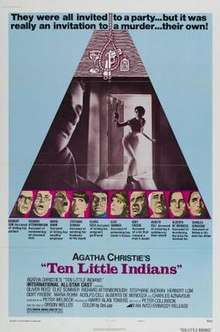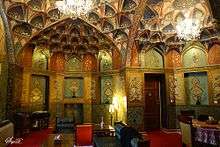And Then There Were None (1974 film)
| And Then There Were None | |
|---|---|
 A film poster bearing the film's title: Ten Little Indians | |
| Directed by | Peter Collinson |
| Produced by | Harry Alan Towers |
| Screenplay by |
Harry Alan Towers (as "Peter Welbeck") Uncredited: Enrique Llovet |
| Based on |
Novel: Agatha Christie |
| Starring |
Richard Attenborough Oliver Reed Charles Aznavour Stéphane Audran Elke Sommer Gert Fröbe |
| Music by | Bruno Nicolai |
| Cinematography | Fernando Arribas |
| Edited by |
John Trumper Gabrielle Reinecke Mike Crowley |
Production company |
Corona Filmproduktion Talía Films COMECI |
| Distributed by | AVCO Embassy Pictures |
Release date | 1974 |
Running time | 98 min. |
| Country | Italy / Germany / France / Spain / United Kingdom |
| Language | English |
And Then There Were None (a.k.a. Ten Little Indians) is a 1974 film adaptation of Agatha Christie's best-selling 1939 mystery novel of the same name.[1] The film was directed by Peter Collinson and produced by Harry Alan Towers.[1] This was the second of three versions of Christie's novel to be adapted to the screen by producer Harry Alan Towers. Two film adaptations were previously released (a 1945 version by René Clair and the 1965 Ten Little Indians). An American made-for-television version was broadcast in 1959.[2] Towers produced a third version in 1989.
Plot
A group of ten people, strangers to one another, have all travelled to a hotel located deep in the deserts of Iran. Upon arrival they discover that their host is mysteriously absent. At dinner, they notice a display of figurines; the Ten Little Indians, as represented in the doggerel in each of their suites. They are accused via a tape recording by the host, U.N. Owen ("unknown"), someone none of them has ever met, of having committed various crimes in the past which went unpunished by the law.
One by one, the guests start to die; first Michel Raven whose drink was poisoned. During the night, the housekeeper/cook, Elsa Martino, makes a mad dash to escape, only to be strangled against a pillar; a method of Ancient Persian execution, as noted by Hugh Lombard. A search of the hotel is intimated by General Salve who splits everyone into pairs. Not long after everyone separates from each other, Salve is stabbed to death in the hotel's catacombs. Their search reveals there is no one in the desert, except their seven selves, and that there is a killer in their midst who is one of them.
The next morning, Elsa's husband, the butler, attempts to escape into the desert, only to expire from heat and exhaustion; his survival kit having been sabotaged. Ilona reveals her tragic past to the others, exposing the cause of her husband's suicide. Later, she is found dead, bitten by a venomous snake. The lights soon short out, leaving the five remaining guests in the dark, where at dinner, they reveal the nature of the crimes they stand accused of. Before Vera can offer her explanation, she leaves the others to return to her room. She screams, and the others rush to her. In the confusion, Judge Cannon is found dead in his bedroom, shot in the head.
Dr. Armstrong poses his suspicions of Vera, and has her locked in her room. Hugh comes to Vera during the night to give her his gun, and reveals that he is in fact Charles Morley; the real Lombard had committed suicide and he took his place instead. In return, Vera herself confesses that she never committed murder and instead was secretly covering up for her mentally ill sister.
In the morning, Dr. Armstrong is nowhere to be found. A search of the ruins leads to Blore being pushed to his death off a ledge. Vera and Morley find the body of Dr. Armstrong in the ruins and realise they are the only two remaining.
Vera shoots at Morley and returns to the hotel where she finds all the furniture sheeted up once more, except for a chair with a noose above. She finds Judge Cannon alive, who reveals how he tricked Dr. Armstrong into helping him fake his "murder", and how he wanted to seek perfect justice and perform his duty as an executioner of the guilty. He tries to convince Vera to hang herself to avoid being publicly executed as the last remaining person alive, the most likely to be the murderer. He drinks poison, and prepares to die, right before Morley appears before him alive. Cannon chokes on the poison and realises his scheme has been foiled before he expires. With Cannon dead, Vera and Morley are picked up by a helicopter as the tape recording is replayed.
Cast
- Charles Aznavour as Michel Raven, entertainer. Raven is accused of having run over two people in Paris while driving under the influence of alcohol.
- Stéphane Audran as Ilona Morgan, actress. Ilona is accused of having been responsible for the death of her husband "in a most cold-blooded and ruthless manner."
- Elke Sommer as Vera Clyde, secretary. Mr. Owen accuses her of having fatally poisoned her sister's fiancé.
- Gert Fröbe as Wilhelm Blore, police official. Accused of committing perjury to frame an innocent man, who subsequently died in prison.
- Herbert Lom as Edward Armstrong, doctor. Accused of having operated on a woman while drunk, causing her death.
- Oliver Reed as Hugh Lombard, businessman. Accused of murdering the young woman who was to bear his child out of wedlock.
- Richard Attenborough as Arthur Cannon, judge. Accused by Mr. Owen of having sentenced an innocent man to death by hanging.
- Maria Rohm as Elsa Martino, servant. Accused of helping her husband cause the death of her wealthy, invalid employer.
- Alberto de Mendoza as Otto Martino, servant. Accused of causing the death of his wealthy, invalid employer after tricking her into including him and his wife in her will.
- Adolfo Celi as André Salvé, military general. Accused of having been responsible for the deaths of five men who were under his command.
- Orson Welles as "U.N. Owen" – the Voice on the Tape
Production

Writing
The 1974 film reuses the script of the 1965 version, even calling Oliver Reed's character "Hugh" instead of "Phillip," which was the character's name in the novel and play. It is set in an abandoned hotel in the Iranian desert.
Casting
Herbert Lom, who plays Dr. Armstrong in this film, also starred in the 1989 version, as the General (played by Adolfo Celi in this version).
Filming
Much of the film was shot on location in pre-revolution Iran. These included the Shah Abbas Hotel in Isfahan (now known as the Abbasi Hotel), Persepolis and the Bam Citadel.[3] Other locations used are the Temple of Debod in Madrid and Almería in Andalucía, Spain.[4]
Versions
The European cut of the film featured a pre-credit sequence that showed the guests arriving by plane before boarding a helicopter to be transported to the hotel. However, this prologue was cut from the US release.
References
- 1 2 Canby, Vincent (24 April 1975). "Film:'Ten Little Indians':Christie Remake in Iran Is a Global Disaster". The New York Times.
- ↑ Christie, Agatha (Source material) & Reisman Jr., Philip (Screenwriter) & Bogart, Paul (Director) (18 January 1959). "Ten Little Indians". TCM.
- ↑ AGATHA CHRISTIE IN PERSIA: Trailer of "Ten Little Indians" (1974), retrieved 3 November 2017
- ↑ IMDB.com retrieved 3 November 2017
External links
| Wikimedia Commons has media related to And Then There Were None (1974 film). |